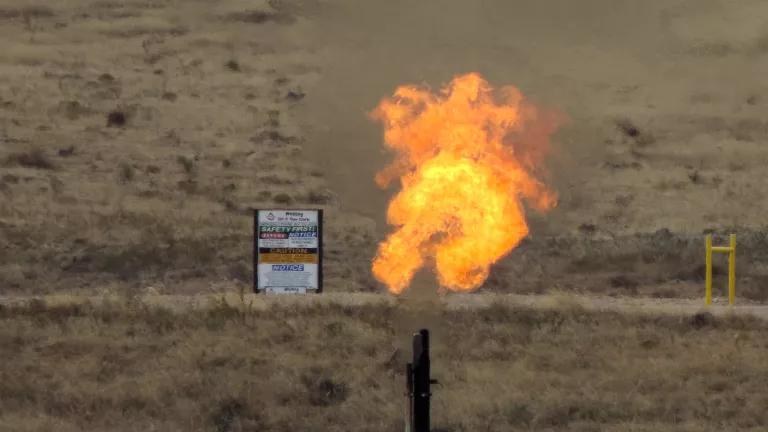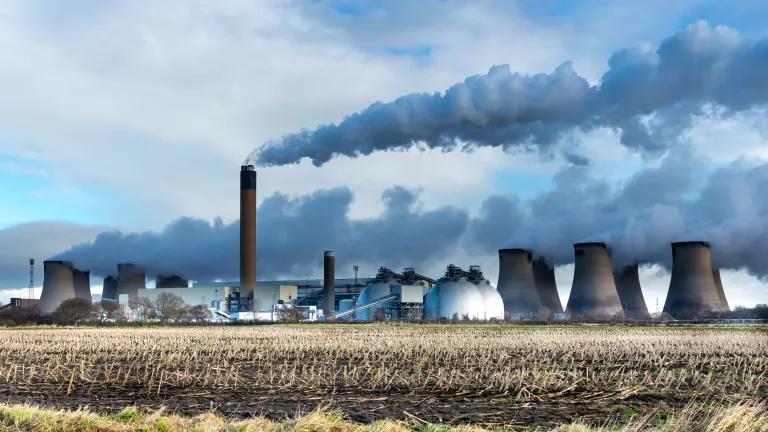We Can’t Drill Our Way Out of High Prices
The oil industry is using Russia's invasion of Ukraine to steer us toward policies that would lock in decades of dangerous and unnecessary oil and gas development that do nothing to make us energy independent or lower energy prices.

Flare burning off waste methane.
With Russia’s unprovoked and sickening invasion of Ukraine roiling international oil and gas markets, the fossil fuel industry and its Congressional enablers are seizing on the crisis to attempt to profit even more. In their cynical self-interest, they’re trying to steer us toward policies that would lock in decades of dangerous and unnecessary oil and gas development that do nothing to make us energy independent or lower energy prices. One of their prime targets? Our shared public lands.
Oil and gas are global commodities traded on global exchanges. When there is a shortage or surplus in one part of the world, we all feel the effect globally. In the U.S., where the oil and gas industry pressed for the lifting of the decades-old oil export ban and exports have subsequently soared, we are now fully integrated into this global marketplace. Oil and gas companies were making enormous profits prior to the invasion of Ukraine and these profits will likely only increase as industry keeps raising the price of oil. Those record profits benefit the small amount of people that own oil and gas company stocks, while leaving the rest of us with higher prices at the pump.
What does that mean for U.S. consumers?
First, the prices we pay are dictated, largely, by the whims of the global market. And oil companies aren’t indirect bystanders in this market – they are major players whose actions determine the prices consumers see at the pump and on our home energy bills. Instability caused by war, pandemics, and sudden changes in supplies will always and have always led to major jumps and falls in the price of oil and gas. When oil prices go up, oil companies benefit as they make larger and larger profits since the oil they are selling today was based upon investment costs from years ago.
Second, the President and Congress have almost no power to change that fact, despite the fountain of rhetoric coming from industry’s foremost lobbying arm, the American Petroleum Institute (API) and its many friends in Congress. There is no magical tap that can be opened to flood the market with oil and gas—something that is especially true if the “solution” to lowering prices is the cynical old chestnut “drill baby drill.” That has never worked, and it certainly won’t work now. And to be clear: today’s pump prices are not a function of domestic policies with respect to drilling that would yield oil a decade or more from now.
There are so many reasons that just “drilling more” or rushing to approve more infrastructure will do nothing to alleviate the situation consumers are living through today. This is especially true for federal drilling, where producers take, on average, more than 10 years from the time of lease issuance until actually producing salable quantities of oil or gas.
Here, I focus on why the oil and gas industry’s and Congress’ calls for more drilling on our public lands is not a solution to the issues we’re facing today, and not a solution moving forward.
- First, as the Biden administration has consistently noted, the oil and gas industry has loads of capacity right now to drill more wells on leased public lands and increase production. As of December 2021, industry was sitting on 9,173 available drilling permits for Federal and Indian lands. According to data kept by the Bureau of Land Management, those permits are equivalent to the number of new wells drilled on federal lands from 2015-2020. In other words, industry is sitting on up to 5 years of new drilling opportunities and many more years of new production opportunities. They don’t need more.
- Second, oil production from Federal and Indian lands in FY2021 is the highest its been since at least 2003 (showing more than 400% growth in that time). Every indication suggests that this upward trend will continue, and the Biden administration is not halting or slowing this trend at this time. Gas production on federal lands has remained largely flat, though on non-federal lands it has risen significantly over a similar period.
- Third, a rush to lease more will simply transfer more of our shared public lands into the hands of the oil and gas industry, foreclosing other uses. These lands are highly valuable to local economies, they support essential ecosystems, and they help stave off the worst effects of climate change. Industry already leases 26 million acres of federal public lands and uses less than 50% of that acreage.
- Fourth, and something often lost in the rhetoric coming from the oil industry and some allies on Capitol Hill, is the basic fact that federal lands are not a significant source of U.S. oil production. According to the latest data, less than 8% of daily production comes from onshore Federal and Indian lands (see data here and here). Production is steadily increasing year-over-year, and long-term trends show that production from federal leases has increased. But the idea that if we just open more lands to more drilling production will increase is based on a dystopian fantasy where our public lands are pummeled by industry with no care for their myriad other values and uses.
There are too many reasons against expanding or accelerating federal fossil fuel leasing to list here. But the reason to reject industry’s current flood of disinformation is simple. The timeline from buying a lease to selling oil on the market is a decade and that’s just business and science, not politics. Encouraging more leasing today won’t get us out of today’s crisis. And as a matter of sheer science, we simply can’t afford to use our public lands to drill more, which would rob our grandchildren’s future both in public land uses and by increasing carbon pollution. It would lock us into more production far into the future, something that is extremely risky for the climate and also extremely risky for global markets.
Oil producers, despite their lobbyists’ tired talking points, not only recognize the risks of ramping up production too quickly, but also the extraordinary profits that can be made by not doing so. They readily acknowledge sitting on large stockpiles of permits and leases that will allow them to follow decades-long production plans while prioritizing profits, shareholder returns, and stock buybacks. Basically, their actions and words show: profits are king and pain at the pump is the consumers’ problem. If they were seriously concerned with the prices consumers are seeing today they could sell that oil and gas to consumers at a discount (i.e., closer to their operational costs than today’s global price) and avoid reaping massive profits on the back of this crisis.
Today we are facing supply shortages, but we have literally just emerged from a severe supply glut during the COVID-19 pandemic that decimated the industry and led to numerous bankruptcies and an orphaned well epidemic. Expanding supplies when the world needs to end our reliance on fossil fuels is not only incredibly irresponsible, but also just basic self-sabotage. When you are in a hole, stop digging.
If Congress is serious about energy independence, stabilizing energy prices for average people, and confronting climate change, the only pathway that will end these economically catastrophic rollercoaster rides is to end our reliance on fossil fuels altogether.




